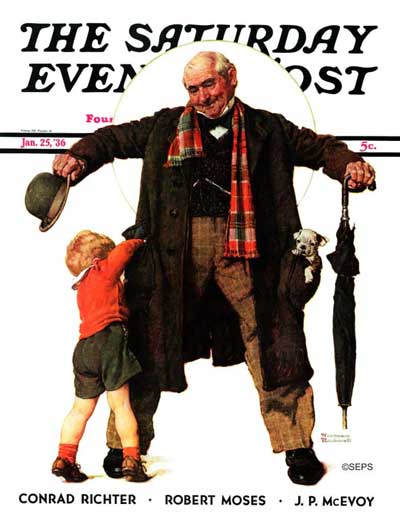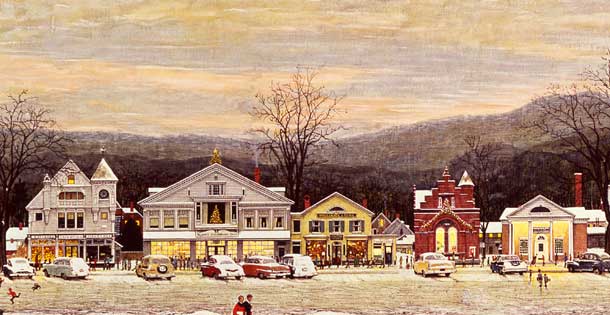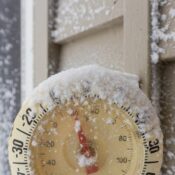
(Image courtesy the Norman Rockwell Family Agency)
Christmas Day is on December 26. That’s what I thought my whole childhood, and even as an adult I continued to confuse it with the 25th. It’s because every year we went up to Pop’s house in Stockbridge, Massachusetts, the day after Christmas. Christmas at my grandfather Norman Rockwell’s was the highlight of that special season. They were the most magical Christmases of my life.
The memories are accompanied with such a vivid sensory awareness. We’d be greeted by Pop and my step-grandmother, Molly, at the kitchen door. The comforting smells of their cook Virginia’s food would surround and embrace us instantly. I would rush in to see the Christmas tree, running through the pantry, then through the hall with the creaky floorboard under the Arthur Rackham pen and ink, into the living room where I would stand in silence before the tree with its fresh pine scent. My favorite ornament was the little, gold guitar with actual strings and rhinestones, and I would search for it every year. The scent of the crackling fireplace in the library — where the adults would have their whiskey sours and the children would have ginger ale — hung in the air throughout the comfortable colonial house. I loved the after-dinner “job” of putting the candles out with the snuffer and watching the smoke mysteriously drift upwards from the extinguished flame. But what stays with me the most powerfully is the intoxicating scent of Pop’s pipe after he lit it, sitting in his big red armchair to the left of the fireplace. To this day on the rare occasion that I happen upon that scent, I am arrested by it and instantly taken back.
People would send my grandfather gifts every year. I remember winding up a music box in the bottom of a Scotch bottle and being entranced by the tiny Scottish dancer in a kilt turning to the tune of “Loch Lomond.” The Russian nesting dolls in the library were my favorite toy that I would play with faithfully, taking each doll out carefully and putting them together in a perfect lineup.

Norman Rockwell
January 25, 1936
Norman Rockwell’s Christmas paintings are some of his most charming and heartening. His connection to Christmas was deepened in his childhood by his Uncle Gil, an eccentric inventor and scientist. Uncle Gil would bring firecrackers at Christmas to celebrate the Fourth of July, Christmas presents on Easter, and chocolate rabbits on Thanksgiving. The next year he would turn things upside down again and bring chocolate rabbits hidden in his pockets for the children on Christmas. Uncle Gil was a character straight out of Charles Dickens [http://www.saturdayeveningpost.com/2015/12/09/art-entertainment/art-and-artists/rockwells-dickensian-series.html], the great storyteller that had such a profound influence on my grandfather and his work. And I think somehow Uncle Gil became the embodiment of the Christmas spirit and this always stayed with Pop. He painted his memory of Uncle Gil in Little Boy Reaching in Grandfather’s Overcoat for The Saturday Evening Post cover, January 25, 1936. The little boy is my father, Thomas.
Home for Christmas (or, Stockbridge Main Street at Christmas) was painted for McCall’s December 1967 issue. It is one of my favorites. The main street of Stockbridge today still looks much the same. The little secret of the painting is the house with black shutters on the far right with all the windows illuminated and smoke coming out of its chimney — that was my grandfather’s home, with his barn red studio next to it, where we spent every Thanksgiving and Christmas. I still dream of that house.
It is easy to get lost in the details of this painting. It is full of life, movement and Yuletide festivity: children playing, shoppers with packages rushing home, cars in transit, people going into the library. But it is the less noticeable details that have always captured my interest. Some windows have candles in them, others don’t but instead have their blinds drawn. Some cars are parked correctly; others are a bit askew, presumably because the snow has erased the lines. I love the visible car tracks in the snow and all the different makes and models of automobiles; the newest one of that Christmas looks a bit like the Volkswagen Beetle, the blue car just left of the darkened inn.
The Red Lion Inn was closed at this time because it had fallen into neglect after one owner, Robert Wheeler, had misguidedly attempted to refashion it as a “motor lodge.” His endeavor failed and the inn went dark, intended for demolition in 1968; a gas station was planned in its place. It was saved by the Fitzpatrick family who purchased the inn that same year; they have run it ever since. Stockbridge is a small town of tradition and neighborly kindness and community — it is what Pop loved about it. That, and the wonderful townspeople he found to paint.
My grandfather’s first studio in Stockbridge was in the building with the big plate glass window with the Christmas tree. It was his studio from 1953–1957. He had the picture window installed to get the north light. At the very far left of the painting is The Old Corner House, the original site of the Norman Rockwell Museum, the white colonial with porch windows.
Pop painted the landscape with a delicate, primitive feel, choosing to layer somber transparent tones of grays and browns. The sky is the perfect cold winter sky after the sun has quickly set. All of these bleak colors serve as a contrast to the brilliant yellow light of the bustling town and vibrant Christmas decorations. It is through this important sense of contrast that the meaning of the holiday season is quietly illuminated — finding the light at the peak of the darkest month.
Many holiday blessings to everyone for a wonderful Christmas and Hanukkah! May the light we find in this season carry us through this next year and usher in a time of increased kindness and peace — in spite of everything we are facing around the world right now.
Warmest wishes,
Abigail
P.S. I just gave the Norman Rockwell Museum Archives my finalized, detailed list of the numerous errors and omissions in the recent fraudulent biography of Norman Rockwell, American Mirror, published in 2013. As many of you know, it is because of this biography that I was compelled to start my “Rescuing Norman Rockwell” Facebook page. The extensive list is not just a refutation of falsifications based on my investigation of the primary sources — it presents a true portrait of my grandfather and his life, including many details and memories that I learned from my father, Thomas Rockwell, Pop’s middle son. It will serve as a guide for future Norman Rockwell biographers and scholars. I am happy that this page that started out as a fight to have the truth heard has ended up being a celebration of Norman Rockwell and his work.
Special thanks to Laura Claridge for her comprehensive research in her 2001 biography, Norman Rockwell, A Life. Her biography was a considerable help to me in my investigation.
Become a Saturday Evening Post member and enjoy unlimited access. Subscribe now




Comments
Thank you, Bob! We had an enchanted Christmas this year, partly because the scandal is well in the past now – the truth has been restored. Thank you for sharing your story and wonderful memories. Many blessings for a bright and beautiful New Year ahead…
Thank you so much Abigail for sharing your childhood memories at your grandfather’s wonderful colonial house there in Stockbridge. Through your descriptive and thorough writing of it, I can almost imagine having been there myself!
I love ‘Home for Christmas’ also,and was not familiar with it before. Indeed I never knew he painted for McCall’s. I did know that he did some really fine work for LOOK magazine from about 1963-’69 regarding social issues of the time, including the Moon Landing!
But getting more down to earth, I like the detail he put into this painting, including the cars of course. It reminds me of an exhibit room I love visiting each August at the Ventura County Fair that have life-like miniature depictions of small towns between the ’30s to the early ’60s. I know every car, and what model year they are to boot. It’s a nice break from a rare, yearly indulgence of mouth watering steak, ribs, freshly baked chocolate chip cookies and more. The best part is the livestock. I love the horses, piglets, and the goats even biting at my pants. I always have a couple of cone-shaped ice cream cones filled with approved goodies for them to feed on. They make me laugh and love that baby talk, like most animals.
Most importantly here, it sounds like you’re well on your way to fixing the fraudulent errors, omissions and more in that ‘American Mirror’ book! I’m sorry you’ve had to go through the grief associated with this debacle, but a lot of good has come out of it; such as this column. I’d love it to continue and I’m sure the Post editors would agree.
I hope this Christmas lives up to your expectations, even if they’re not quite the same as the more vintage ones over at Pop’s—-on the 26th!